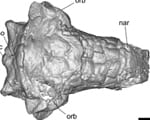“’We could have another sink hole or two or 10 someday show up,’” (Winkler County Sheriff George) Keely says. In fact, the SMU researchers used satellite imaging to show the problem is getting worse.”
KERA public radio news covered the research of SMU geophysicists Zhong Lu, professor, Shuler-Foscue Chair, and Jin-Woo Kim research scientist, both in the Roy M. Huffington Department of Earth Sciences at SMU.
KERA’s article, “Near Wink, Texas, The Sink Holes Are Getting Bigger And Bigger,” aired June 28, 2016.
The Dedman College faculty are co-authors of a new analysis using satellite radar images to reveal ground movement of two giant sinkholes near Wink, Texas. They found that the movement suggests the two existing holes are expanding, and new ones are forming as nearby subsidence occurs at an alarming rate.
Lu is world-renowned for leading scientists in InSAR applications, short for a technique called interferometric synthetic aperture radar, to detect surface changes that aren’t visible to the naked eye.
Lu is a member of the Science Definition Team for the dedicated U.S. and Indian NASA-ISRO InSAR mission, set for launch in 2020 to study hazards and global environmental change.
InSAR accesses a series of images captured by a read-out radar instrument mounted on the orbiting satellite Sentinel-1A. Sentinel-1A was launched in April 2014 as part of the European Union’s Copernicus program.
Lu and Kim reported the findings in the scientific journal Remote Sensing, in the article “Ongoing deformation of sinkholes in Wink, Texas, observed by time-series Sentinel-1A SAR Interferometry.”
The research was supported by the U.S. Geological Survey Land Remote Sensing Program, the NASA Earth Surface & Interior Program, and the Shuler-Foscue Endowment at Southern Methodist University.
EXCERPT:
KERA Public Radio News
The earth is crumbling in West Texas. Scientists from Southern Methodist University have new research that shows two massive sinkholes between the towns of Wink and Kermit are expanding.Years of drilling for oil and gas have helped wash away salt beds underneath the ground. A shifting water table has made the problem worse and in some places the ground is sinking five inches a year, according to the satellite readings.
Now there’s concern the pits could converge into one giant hole. “A collapse could be catastrophic,” SMU research scientist Jin-Woo Kim said.
These wounds in the West Texas desert have been around for years. The first hole opened up near an abandoned oil well on June 3, 1980. Twenty-two years later, about a mile away, the second one appeared. From the sky, they look like high-caliber bullet holes
“It’s pretty scary. It’s just a big huge pit,” said Winkler County Sheriff George Keely, who has peered over the edge many times in his career. “It’s like standing on the moon looking into a crater. And you can see where it’s just caved off. It’s broken off over the years more and more. When you look down there, you’re looking at water.”
Water is the problem. West Texas, not far from Odessa, is oil country. Drillers started working near
Wink in the mid-1920s. For decades, they injected water into the ground and destabilized the earth, according to the researchers. Meanwhile, as the water table shrinks, thick layers of salt are dissolved far below the surface.
It’s like kicking the legs out from underneath a chair.


 To request an interview with Zhong Lu call SMU News and Communications at 214-768-7650 or email SMU News at
To request an interview with Zhong Lu call SMU News and Communications at 214-768-7650 or email SMU News at  To request an interview with Jin-woo Kim call SMU News and Communications at 214-768-7650 or email SMU News at
To request an interview with Jin-woo Kim call SMU News and Communications at 214-768-7650 or email SMU News at  Early armored dino from Texas lacked cousin’s club-tail weapon, but had a nose for danger
Early armored dino from Texas lacked cousin’s club-tail weapon, but had a nose for danger SMU physicists: CERN’s Large Hadron Collider is once again smashing protons, taking data
SMU physicists: CERN’s Large Hadron Collider is once again smashing protons, taking data Nearby massive star explosion 30 million years ago equaled brightness of 100 million suns
Nearby massive star explosion 30 million years ago equaled brightness of 100 million suns Text in lost language may reveal god or goddess worshipped by Etruscans at ancient temple
Text in lost language may reveal god or goddess worshipped by Etruscans at ancient temple Good news! You’re likely burning more calories than you thought
Good news! You’re likely burning more calories than you thought